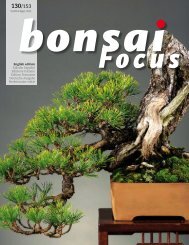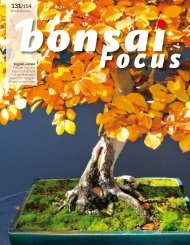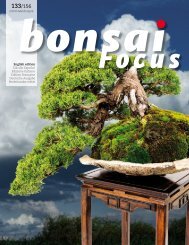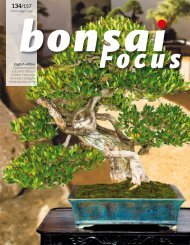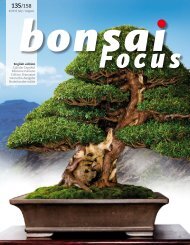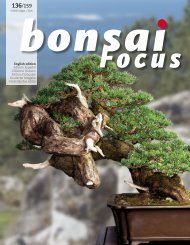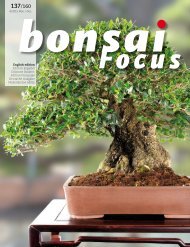BONSAI FOCUS 2016-2 EN PREVIEW
Discover how fascinating Bonsai Focus is! With informative reports and stunning photography every two months, Bonsai Focus Magazine makes you eye-witness extraordinary bonsai, magnificent stylings of famous masters, educational techniques and useful maintenance tips. Articles are often supported by exclusive and breathtaking videos.
Discover how fascinating Bonsai Focus is! With informative reports and stunning photography every two months, Bonsai Focus Magazine makes you eye-witness extraordinary bonsai, magnificent stylings of famous masters, educational techniques and useful maintenance tips. Articles are often supported by exclusive and breathtaking videos.
Create successful ePaper yourself
Turn your PDF publications into a flip-book with our unique Google optimized e-Paper software.
139/162<br />
2/<strong>2016</strong> March / April<br />
English edition<br />
Edición Español<br />
Edizione Italiano<br />
Edition Française<br />
Deutsche Ausgabe<br />
Nederlandse editie<br />
Noelanders Trophy XVII
Bonsai Focus<br />
EDITORIAL<br />
3<br />
Who we are<br />
Publisher<br />
Bonsai Europe Publications<br />
Houtrustweg 96,<br />
2566 GJ The Hague<br />
The Netherlands<br />
The studio of Michael Hagedorn and the three demo artists. From left<br />
to right: Boon Manakitivipart, Matt Reel and Bobby Curttright<br />
Europe:<br />
Tel.: +31 (0)85 90 20 900<br />
Office hours: 9am - 5pm (CET)<br />
USA:<br />
Tel.:(+1) 703-738-9965<br />
Office hours: 9am - 5pm (East Coast)<br />
E-mail:<br />
info@bonsaifocus.com<br />
Website:<br />
www.bonsaifocus.com<br />
Chief Editor:<br />
Farrand Bloch<br />
editor@bonsaifocus.com<br />
Editorial staff:<br />
English edition: Ann Scutcher<br />
French edition: Patrick Bosc, Matthieu<br />
Mavridis<br />
German edition: Jörg Derlien<br />
Dutch edition: Hein-Dik Barentsen<br />
Italian edition: Erika Lakin<br />
Spanish edition: Ana Ricart<br />
Advertising & Marketing:<br />
René Rooswinkel<br />
sales@bonsaifocus.com<br />
Subscriptions & Administration:<br />
Marja Heijmink<br />
admin@bonsaifocus.com<br />
Issn UK: 1874 - 6853<br />
Issn US: 1876 - 6137<br />
Price: € 12.80<br />
© Copyright <strong>2016</strong><br />
Bonsai Europe, world rights reserved. No<br />
part of this publication may be reproduced<br />
in any form without the written<br />
permission of the publisher.<br />
Bonsai Focus has a co-operation with<br />
Kinbon magazine, Kyoto, Japan<br />
Three in a row<br />
So here I am, once again writing my<br />
introduction to the latest edition of our<br />
magazine. I have just returned from the<br />
Nöelanders Trophy XVII, which proved<br />
to be a mega event. Our large stand was<br />
sited in the main hall, just across from<br />
the entrance – the perfect place for the<br />
wonderful meet and greet we had with<br />
many of our readers. The smile on my<br />
face just got bigger and bigger as we were<br />
showered with wonderful compliments<br />
for the last issue which was received<br />
enthusiastically. The Nöelanders Trophy<br />
show is really the opening event of the<br />
new bonsai season and this edition was<br />
even bigger than before; it has become<br />
the largest show in Europe. You will find<br />
the full report in this issue.<br />
During our visit to the US last year for<br />
the Artisans Cup in September, we made<br />
a stopover at Michael Hagedorn's studio.<br />
He very kindly hosted the day of demos<br />
we planned with Boon Manakitivipart,<br />
Matt Reel and Bobby Curttright, Michael's<br />
apprentice. Michael has a great collection<br />
and garden and also a huge studio with<br />
white walls, just perfect for photography.<br />
So I ended up with three demonstrating<br />
artists in a row, which is a kind of record<br />
for me taking the shots and a video. Boon<br />
Manakitivipart is the first of the artists<br />
to be featured in this new series. See him<br />
working on a Rocky Mountain juniper.<br />
We had featured him some time ago in<br />
2009. He is an admirable man, always up<br />
for some jokes to lighten the atmosphere.<br />
This really helped to smooth the way and<br />
made the photo shoot so much easier for<br />
me to manage.<br />
Another impressive item which came<br />
about from our Portland adventure is the<br />
group of bonsai images by photographer,<br />
Chris Hornbecker. These were printed<br />
poster size and hung in the exhibition<br />
hall of the Artisans Cup. I was fascinated<br />
by those images and got to talk to Chris,<br />
asking about his motivation. Further on in<br />
the magazine he shares his thoughts and<br />
we show you some of these prints.<br />
Enjoy the read.<br />
Translations:<br />
Peter Warren<br />
Farrand Bloch<br />
Chief editor
4 Bonsai Focus<br />
THIS ISSUE<br />
Our Icons<br />
Video available<br />
bonsaifocus.com<br />
Scan the code<br />
with your phone<br />
Beginner<br />
Advanced<br />
Expert<br />
On the cover<br />
The Nöelanders Trophy XVIII. Winning<br />
trees: Picea glehnii (Luis Vallejo) and Acer<br />
palmatum (Warren Radford).<br />
Photo: Bonsai Focus Studio<br />
31<br />
6 News<br />
Various events and reports, agenda of coming events<br />
8 The Nöelanders Trophy XVII<br />
The full report of the Nöelanders show in Genk, Belgium<br />
18 Artists unite<br />
Chiharu Imai and his team work on a huge juniper<br />
26 Interview<br />
Sandro Segneri is a very remarkable artist<br />
36<br />
29 The displays of the Taikan-ten<br />
Award winning displays of bonsai, scrolls and suiseki<br />
31 Pots from Sweden<br />
Thor Holvila from Sweden has a different<br />
approach to pot making<br />
34 The sea of colour<br />
Tony Tickle travels to India<br />
36 Top without top<br />
Hotsumi Terakawa re-models a small juniper<br />
8
Bonsai Focus<br />
44 Expert opinion<br />
François Jeker analyses Jurgen Steven's juniper<br />
18<br />
46 The root dentist<br />
In Japan roots are corrected just like dentists do it<br />
54 Webshop<br />
A variety of products at special prices for subscribers<br />
56 Rocky 2<br />
Boon Manakitivipart works on a Rocky Mountain juniper<br />
66 Reality cast in bronze<br />
Miniature bronze sculptures for bonsai<br />
68 Garden visit<br />
A peek in Henk Grob's bonsai garden<br />
69 Tony's column<br />
The desire to show your bonsai<br />
46<br />
72 Sowing the seeds<br />
The challenge to grow a beech from seed<br />
78 Floating bonsai<br />
The photographic works of Chris Hornbecker<br />
56
NEWS<br />
6 Bonsai Focus<br />
The cryptomeria man<br />
By: Andrés Álvarez Iglesias.<br />
The 'cryptomeria man', Jose Ontañon,<br />
has recently passed away due to a heart<br />
attack. As well as being a very good and<br />
honest friend, he was a guy with lots of<br />
good positive vibes — a perfectionist with<br />
a very distinctive way of creating great<br />
bonsai. The soul of Jose has been so great<br />
and everything he had always created so<br />
magnificent that we will never be able to<br />
forget him, nor do we want to. We enjoy<br />
our memories of him, we miss him and<br />
dream that we'll meet again some day.<br />
We had one of his Cryptomeria displayed<br />
during the last edition of the Nöelanders<br />
Trophy to honour his work.<br />
Museum quality bonsai in<br />
Rochester: the 5th US National<br />
Bonsai Exhibition<br />
This coming September the best bonsai<br />
can be admired in Rochester New York<br />
(USA). The bi-annual show initiated and<br />
organised by Bill<br />
Valavanis continues<br />
to improve with every<br />
edition. This year<br />
special demos will<br />
be held by Minoru<br />
Akiyama (Japan), Tony<br />
Tickle (UK), Enrique Castano (Mexico),<br />
Sean L. Smith (US) Peter Warren (UK), Ryan<br />
Jose Ontañon and his famous cryptomeria, at<br />
the 14th edition of the Nöelanders Trophy<br />
The three students of Masahiko Kimura<br />
come to Saulieu<br />
There are still many months to go before one of<br />
the top shows will again be held in Saulieu. The<br />
European Bonsai San Show <strong>2016</strong> takes place on the<br />
weekend of 15th - 16th of October. This time there<br />
will be a special edition with the three disciples of<br />
Masahiko Kimura coming for demonstrations. More<br />
information: www.european-bonsai-san-show.com<br />
Michael Bell (US). Total Sports Experience,<br />
435 W. Commercial St, East Rochester NY.<br />
Promoting bonsai in India<br />
Sanjay Dham, one of the organisers of the All India<br />
Convention held last November, 2015 in Vadodara,<br />
received from Ms Solita Rosade (Chair of the event) a<br />
Certificate of Merit, signed by all the international and<br />
national artists. It said 'In appreciation for organising<br />
and promoting bonsai in India'. 'This is in reward for<br />
the two years' hard work in promoting the convention<br />
and its execution,' Sanjay Dham explained.<br />
30 April - 3 May<br />
National Bonsai Exhibition, Poland<br />
Guest demonstrators: Sae Won Kim, Seok Ju Kim,<br />
Walter Pall, Václav Novák, Bjorn Bjorholm, Milan<br />
Karpisek. Where: Ksiaz Castle, Piastów Slaskich 1,<br />
58-306 Wałbrzych, Poland.<br />
Info: www.bonsai-ogrody.com.pl<br />
14 - 15 May<br />
The Rencontres<br />
Internationales de<br />
bonsai<br />
Exhibition, trade stands<br />
and demonstrations by<br />
Jean Paul Polmans (BE)<br />
Enzo Ferrari (CH) and<br />
François Jeker (FR)<br />
Open from 10.00 - 18.00.<br />
At: L'Aronde Riedisheim,<br />
20 Rue d'Alsace 68400<br />
Riedisheim.<br />
13 - 15 May<br />
40th Anniversary of the National Bonsai<br />
& Penjing Museum<br />
Reopening of the renovated Japanese Pavilion.<br />
Where: 3501 New York Ave NE, Washington, DC<br />
20002, USA<br />
20-23 May<br />
The 29th Australian National Bonsai<br />
Convention<br />
Where: Hobart, Tasmania, Australia. Info: www.<br />
bonsai-southern-tasmania.org.au/convention.php<br />
20 -22 May<br />
EBA (European Bonsai Association)<br />
Where: Székesfehérvár, Hungary<br />
28 - 29 May<br />
French National Congress<br />
Demonstration by Koji Hiramatsu, at: Pallacium<br />
Villeneuve D'Ascq, France.<br />
Info: 0033 6 22 03 17 42 or www.ffbonsai.com<br />
28 May - 6 June<br />
45th Kanuma Satsuki Festival<br />
Exhibition, Contest and Sales. Where: 2086-1 Moro<br />
Kanuma-shi Tochigi 322-0026 Japan.<br />
Info: t-sanjo@kaboku.or.jp.
30 DISPLAY<br />
Bonsai Focus<br />
Stone: Kamogawa stone 'Hira<br />
Renpou / Hira mountain range'.<br />
Length: 58 cm / 22¾" Width 30 cm<br />
/ 11¾" Height 9 cm / 3½"<br />
Douban: Kibundou<br />
Displayed with a five needle pine<br />
in a Japanese eight-sided pot and a<br />
bronze boat<br />
Stone: Kamogawa stone (previously seen in the Suifu Sanjin<br />
collection) Length: 19 cm / 7¼" Width: 11 cm / 4¼"<br />
Height: 9 cm / 3½". Suiban: Rectangular Celandon ware.<br />
Displayed with red pine in a Nanban round pot<br />
The semi cascading pine tree looks out<br />
across the mountains and rivers while<br />
over head, migratory geese fly off for the<br />
winter. A very well matched scene<br />
Tree: Five needle pine<br />
Height 42 cm / 16½"<br />
Displayed on a Kamogawa itokake<br />
stone with an accent plant.<br />
The natural character of the stone<br />
has been accentuated well and the<br />
height of the display table draws<br />
attention to the image of<br />
the full moon<br />
Using the 160 cm / 63" tall reed as the<br />
main item in this display was a master<br />
stroke. The sense of scale created makes the<br />
large suiban containing the Iyo stone look<br />
like a vast lake. The sense of playfulness in<br />
this display is accentuated by the refined,<br />
but jovial scene represented in the wood<br />
block print<br />
A shohin display created in front of a fusuma (painted screen)<br />
Main Kusamono: Toda reed Height: 160 cm / 63"<br />
Pot: Udei round. Displayed with a stone in a<br />
Japanese suiban
Bonsai Focus<br />
POTS<br />
31<br />
Simple and<br />
stubborn<br />
Thor Holvila from Sweden has a different<br />
approach to pot making<br />
Text and photography: Bonsai Focus Studio<br />
How did you get into bonsai<br />
pottery?<br />
Like most bonsai potters it began by<br />
making pots for my own trees. I started<br />
producing pots for others in 2008 once I<br />
had my own pottery studio. I graduated<br />
from Schillerska Art School in 1989, but I<br />
recently met an old classmate who said<br />
that even then I was talking of becoming<br />
a bonsai potter. I cannot remember<br />
this, but sometimes life leads you to your<br />
dreams.<br />
What is the most important<br />
thing you learned from your<br />
teacher?<br />
My father Berndt Thor Holvila, who was<br />
a judo instructor and also a goldsmith,<br />
taught me how to appreciate Japanese<br />
art and tradition, as well as the simplicity<br />
and stubbornness that was already in my<br />
childhood. Technology and the knowledge<br />
of clay and kilns I received when I was an<br />
apprentice under-potter to Paula Lindfors<br />
(pioneer in the Swedish raku technique).<br />
As a good teacher she would question<br />
everything I did and, above all, she got me<br />
to work with larger sizes. She made me<br />
dare to put small tea pots aside and to<br />
build and think big. The only limitation is<br />
the size of the kiln.<br />
Why ceramic? What do you find<br />
so fascinating about it?<br />
Unlike work as a blacksmith, or crafting<br />
wood, clay has the property that allows<br />
you to work with it until you're satisfied;<br />
after firing, you cannot change anything.<br />
It suits my personality well for I like to<br />
contemplate what I want to do and where<br />
I want to go, consider my choices before<br />
I decide. After that, I seldom turn or look<br />
back.<br />
What is your philosophy of<br />
bonsai ceramics?<br />
I want to stick with simplicity. I stay with<br />
the old techniques, simple tools and a few<br />
quality materials. That way I stay with<br />
tradition and have a relationship with the
34 Bonsai Focus<br />
REPORT<br />
The sea of colour<br />
All India Bonsai Convention & Exhibition, Vadodara<br />
Text and photography: Tony Tickle<br />
Tony Tickle has travelled to many countries throughout the world for the purpose of bonsai. Last year in November he<br />
received an invitation to shows his skills and charm during the Vadodara Bonsai Convention in India — a fascinating<br />
country with a fast growing bonsai scene<br />
Imagine the Prime Minister of the UK<br />
or the President of the European Union<br />
sending best wishes to the organisers<br />
and participants of a bonsai convention.<br />
I somehow don't see this happening, yet<br />
this is just what happened in Vadodara.<br />
Narender Modi, India's charismatic new<br />
Prime Minister did just that, such was the<br />
importance of this event in the Indian<br />
calendar. November 2015 saw the second<br />
All India Bonsai Convention & Exhibition<br />
in Vadodara. The event was held at The<br />
Surya Palace, a large and beautiful hotel<br />
in the middle of the city. The organising<br />
committee was from the Banyan Bonsai<br />
Club Vadodara and our hostess was the<br />
president Chanda Agrawal. The weekend<br />
began with a fabulous display of local<br />
culture and music; colourful and exciting,<br />
the stage overflowed with twirling and<br />
weaving dancers, musicians and sword<br />
fighters. 230 delegates enjoyed the work<br />
of artists from across the globe who were<br />
invited to present their ideas; Peter Chan<br />
(UK) spoke about Zen and its affinity with<br />
bonsai, Lamngoc Vinh (Vietnam) showed<br />
his skill in creating stone landscapes.<br />
Lindsay Farr gave entertaining insights<br />
into his video presentations, Nacho Marin<br />
(Venezuela), Sergio Luciani (Argentina),<br />
Masashi Hirao from Japan<br />
Welcoming dancers<br />
the young Masashi Hirao (Japan), Chase<br />
Rosade (USA), Quingquan Zhao (China),<br />
Robert Stevens (Indonesia), Tony Tickle<br />
(UK), all worked on native material. They<br />
were supported by a group of talented<br />
local artists. The audio/video equipment<br />
was impressive, three giant projection<br />
screens around the room, wireless mics<br />
on all artists, individual spotlights on<br />
demos, three video camera operators, a<br />
production director and a long jib camera<br />
able to sneak in for close ups or dynamic<br />
fly overs of the work on stage. I have<br />
yet to see this at any other show I have<br />
been to —a benchmark for future shows<br />
perhaps?<br />
Oldest civilization<br />
India stands as one of the world's oldest<br />
civilizations and being a multi-cultural<br />
and multi-religious society, it was great<br />
to see this being reflected in some of<br />
the exhibits. More than 75 trees were on<br />
display in one of the lower floors of the<br />
hotel. Well lit and beautifully presented,<br />
the exhibition was viewed by more than<br />
30,000 visitors. Many of the species would<br />
be unfamiliar to artists in the West: Ficus<br />
bengalenses, Casuarina, Operculcaria, Burserra<br />
fagaroides, Murraya exotica, Tamarindus,<br />
Premna obtusifolia, Jaquinia, Pithecellobium<br />
featured in the exhibition. A lot of trees<br />
had clearly been worked over many years,
46 TECHNIQUE<br />
Bonsai Focus<br />
Fagus sylvatica<br />
The root dentist<br />
In Japan roots are corrected and repositioned just as dentists do it<br />
Text and photography: Kinbon magazine, Japan<br />
According to Iemitsu Ooishi repotting is hard work, but very enjoyable. You have the opportunity to study the health of<br />
the root system and to make important corrections to it. Here he shows us how to make these special adjustments using<br />
ropes — sometimes even whips — to improve the roots<br />
Read more:<br />
You will find more on the techniques of<br />
Iemitsu Ooishi in our previous issues: 3/2008<br />
and 6/2015
Bonsai Focus<br />
TECHNIQUE<br />
47<br />
Trees that have already been repotted are lined up in their winter quarters<br />
Many trees with superb nebari are found on Mr Ooishi’s benches<br />
Although the nebari is not bad, Mr Ooishi points out several<br />
faults that need correcting, demonstrating his determination to<br />
achieve perfection. 'You only get the one chance to see and work<br />
on the roots every two or three years. It is essential to make the<br />
most of the opportunity.<br />
'With this material we'll look at procedures for transplanting as<br />
well as the professional techniques and tips for correcting and<br />
improving faults in the nebari.<br />
'This isn't only restricted to the beech, but can also be applied to<br />
most deciduous trees. '<br />
The nebari as seen from the right<br />
Beech: Height: 63 cm / 24¾"<br />
Width: 60 cm / 23¾" Trunk: 11<br />
cm / 4¼"<br />
The nebari as seen from the back<br />
and from above
56 Bonsai Focus<br />
MASTERCLASS<br />
Rocky 2<br />
Boon Manakitivipart styles a Rocky Mountain juniper<br />
Text and photography: Bonsai Focus Studio<br />
Our first visit to Boon in 2009 was at his old garden in the Bay Area of San Francisco. This time we met at Michael<br />
Hagedorn's garden in Milwaukie near Portland, Oregon (USA). A whole team was assembled for the demonstrations<br />
specially carried out for Bonsai Focus magazine, with Michael's student Bobby Curttright, Matt Reel and last, but by<br />
no means least, Boon Manakitivipart. Here he works on a Rocky Mountain juniper showing his approach to a truly<br />
American tree<br />
The team: Boon, Matt, Michael and Bobby are all working on<br />
trees that we will show later on. First, we have Boon's demo<br />
on a Rocky Mountain juniper<br />
A part of Michael Hagedorn's garden; at<br />
the back his large studio is where we did<br />
the demonstration shoots
72 Bonsai Focus<br />
TECHNIQUE<br />
Sowing the seeds...5<br />
Fagus: The challenge is to create a finished tree starting from zero<br />
Text and photography: Kinbon magazine, Japan Illustrations: Kyousuke Gun<br />
One of the ultimate challenges in bonsai is to create a tree from seed.<br />
This time we focus on beech and follow it through the years from seed to a formal upright<br />
Leaf and seed type<br />
In places with strong wind, you will see trees growing into shapes<br />
that defy imagination. 1,700 m / 5,577 ft elevation.<br />
Low elevation trees<br />
Seeds are smaller<br />
High elevation tree<br />
Seeds are larger<br />
Leaves are large,<br />
thinner and<br />
the edge is less<br />
defined<br />
Leaves are small and<br />
leathery, the leaf edge is<br />
finely toothed<br />
Seed shape<br />
Seed<br />
Relatively flat<br />
Leaf starts to twist<br />
slightly<br />
Trees growing at a higher elevation tend<br />
to have more compact growth habit,<br />
smaller leaves and whiter bark<br />
Popular variety<br />
Beech (Fagus) is a deciduous species that<br />
grows up to 30m / 98' tall and has an alternate<br />
leaf structure with oval or elliptically<br />
shaped leaves with serrated edges.<br />
There are several different varieties growing<br />
in Japan, with high and low elevation<br />
varieties showing distinct differences in<br />
leaf and bark characteristics. The most<br />
popular variety used in bonsai is the<br />
white barked high elevation variety found<br />
in more northerly areas.<br />
More specifically, the best trees come<br />
from the Pacific Ocean side of Mount<br />
Fuji or from the Mount Odaigahara area<br />
of Nara Prefecture, both of which have<br />
extremely small leaves. So called 'Fuji-<br />
Buna' are the most popular among bonsai<br />
enthusiasts.<br />
Beech is appreciated throughout the<br />
year for its beautiful white bark, for the<br />
shimmer of the buds as they break in the<br />
spring, the refreshing green foliage in the<br />
summer and the brown autumnal foliage.<br />
No other tree gives the same image of a<br />
high mountain deciduous tree throughout<br />
the four seasons as well as beech.<br />
In terms of shape and style, the traditional<br />
image of large trees is one of a<br />
formal upright, straight trunked tree, but<br />
beeches are often made into forests, too.<br />
It's a species that thickens rapidly and is<br />
a good candidate for growing from seed<br />
as the techniques are not too difficult and<br />
it is relatively easy for beginners.<br />
The most important thing when growing<br />
from seed or seedling is to use a variety<br />
that has good leaf characteristics.
Bonsai Focus<br />
NEXT ISSUE<br />
81<br />
Issue 140 May / June<br />
Workshop with Hiromi<br />
Hiromi Tsukada is a specialist in Satsuki creations. In the next<br />
issue he will show you how to work on a smaller tree.<br />
After the blossom<br />
The aftercare given to Satsuki Azalea is crucial; learn all the ins<br />
and outs.<br />
The eye of the Taiga<br />
Taiga Urushibata is becoming a regular guest here in the West.<br />
He has a sharp eye for detail, which you can see as he works on<br />
a large pine.<br />
Japan in Florida<br />
A visit to Erik Wigert's bonsai nursery in Florida, USA
For the complete<br />
Subscribe now!!<br />
You are just<br />
one click away!!



